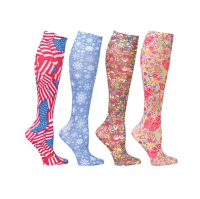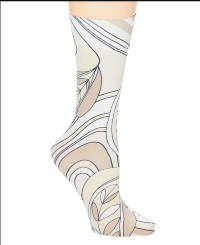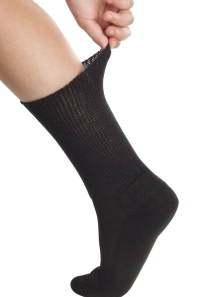The problem of varicose veins most commonly occurs on the legs. Vein enlargement is due to the widening of the vein walls when the veins dilate and blood is retained, which may also cause the skin to harden and become darker or redder.
Varicose veins may commonly be hereditary, but there are other risk factors. As a rule, veins of the lower extremities are affected.
The patient may feel constant fatigue and heaviness in the legs. Sometimes, there can be tingling, numbness and loss of feeling. Varicose veins are dangerous because they can lead to the development of thrombosis and thromboembolism.
Methods for treating varicose veins
Several methods are used to treat varicose veins: compressions, vein creams, sclerotherapy, and surgical treatment. In any case, a consultation with your doctor is necessary to determine which type of treatment is most appropriate for you. Treatment depends first and foremost on the condition of the veins.
The main treatment method is compression.
Are vein socks the ideal solution for you? Give your feet the relief and comfortable feeling they’ve been waiting for with vein socks that are stylish, affordable and comfortable to wear every day. Try vein socks and you’ll never want to give them up for anything else!
Do you have a problem with varicose veins?
Varicose veins are a widespread health problem, but they appear mostly in the elderly and in younger people. The genetic factor plays an important role, as do our habits and professions. Therefore, it is recommended that you act promptly to prevent them by with exercise and regularly wearing compression socks.
Compression socks can be therapeutic as well as preventative. Different vein diseases require different levels of compression, so therapeutic socks and appropriate compression levels should only be recommended by a doctor. They can be of varying lengths, from knee-length to hula hoop. Depending on the type of illness, the doctor prescribes socks of appropriate quality from semi-transparent and highly elastic to very strong and thicker socks of a durable weave.
What are the habits that create varicose veins? Veins occur when the so-called valvular veins are damaged making blood flow more difficultly through the legs to the heart. Then, the blood begins to linger around your arteries and veins. Over time, damaged vein valves can cause varicose veins.

What are vein socks and what makes them special?
The pressure (compression) that these socks place on the joints and feet tightens the superficial arteries and veins, helping the valvular valves (vein valve) to function properly and return blood to the heart without obstruction. That’s why they’re also called compression socks.
Are vein socks the ideal solution for you? Give your feet the relief they’ve been waiting so long for with vein socks that are stylish, affordable and comfortable to wear every day. Try vein socks, and you’ll never want to change them for anything else!

Vein socks are a special type of elastic socks that support healthy blood circulation and help prevent various medical conditions, including chronic venous insufficiency, so-called spider veins, and varicose veins.
We are here to give you all the information on vein socks used for a particular health problem. We will also show you what all types of compression socks are available today. They are available in a variety of colors and styles – leggings, knee pads, finger less and ankles.
Types of socks
Medical socks
These socks have multiple levels of compression – generally from 15 mmHg to 40 mmHg.
Leggings
These socks include hundreds of different styles and quality manufacturers. The comfortable compression of these socks provides the greatest compression around the ankles to create better circulation for the deep veins.
All knee socks provide medical compression for compression therapy. Whether in mild or firm compression, compression therapy can strengthen the venous integrity to prevent swelling.
There are many styles – classic, open-ended, diabetic, microfiber, etc.
Knee-pads
These vein socks are ideal for men and women who need full-leg compression to treat poor circulation or symptoms related to vein disease. These socks provide effective compression and can be worn discreetly under your pants. They are available in mild compression of 15-20 mmHg and solid compression of 40-50 mmHg. Outer vein socks will help relieve the feeling of fatigue in the legs as they reduce swelling and stimulate circulation.
How to use vein socks?
It is extremely important to put on your vein socks in the morning even before you get out of bed.

Sleeping horizontally makes the vein valves more functional than when sitting or standing. In a vertical position, gravity does its thing and blood flow is compromised by damaged vein valves. This is why you usually feel relief in your ankles and feet in the morning than during the day when they are already swollen.
Putting on vein compression socks in the morning will keep the vein valves in proper position and support healthy blood circulation in the legs throughout the day.
If you have already developed varicose veins, vein socks can help you relieve symptoms such as:
Swollen ankles
Heavy or sore feet
Fatigue and pain
Restless legs
Night leg cramps
How to choose the right compression level for vein socks?

You should always talk to your doctor for advice on the right level of compression.
There are three main levels of compression for vein socks and it is very important to know which level is appropriate for you.
Compression levels
Mild compression – Should be used if you have mild chronic venous insufficiency to support healthy blood flow so your feet feel easier
Moderate compression – is more effective and is usually recommended when experiencing symptoms of so-called spider veins or varicose veins
Solid and very tight compression – generally recommended by the doctor in more serious cases of various vein diseases, including deep vein thrombosis, leg ulcers, and lymphatic edema.
What are mild compression socks?
Most of us require mild compression socks. About 20 mmHg of compression should be suitable for most people. For example, the best athletic socks with compression will allow a greater range of motion and require a lower degree of compression than medical socks. Likewise, the best travel compression socks require less compression unless you are treating a medical condition.
These socks are already a little more expensive ( it all depends on the brand). They are suitable for long sitting or standing at work as well as for frequent travel. They help you avoid swollen feet. Compositions are made of soft cotton and heat-regulating fibers that allow the skin to breathe and are comfortable to wear. Mild compression socks can be worn all day, every day. Because they have elastic fibers, the sock remains in the ideal position. They are available in a wide range of colors.
The compression of these socks is 1 or 18-21 mmHg – a mild compression on the superficial veins. It is used for the prevention of venous diseases, for the sensation of weight and fatigue in the legs as well as for the prevention of varicosity in pregnancy.
Who should wear mild compression socks?

Pregnant women
People with tired, sore feet
Anyone with swollen legs and ankles
Someone with mild to moderate swelling of the legs
People who stand or sit for long periods
Overweight people

Many people simply like to wear these socks because they are comfortable. However, you should consult your doctor before opting for pressure gradient vein socks. They are also suitable and very comfortable for athletes as they improve circulation, help you to recover faster and fight foot fatigue.
How to Take Care of Mild Compression Stockings?
In the evening, before bedtime, socks should be removed and washed. Washing is important as the material will stretch and release pressure after wearing and the fabric picks up skin flakes, sweat and cream residue during the day, which can damage the fibers and cause them to lose elasticity. Wash them at a temperature of up to 40˚C with a mild detergent and without softener. They should never be dried in the sun or on a radiator or ironed, as this will significantly shorten their life span.
Taking care of your vein socks is not hard work, but there are a few things to keep in mind if you want to use them for as long as possible:
Use cold or lukewarm water to wash these socks.
Wash by hand instead of using a washing machine.
Do not use a softener – just soap or mild detergent.
Never place them in a dryer.
Popular Articles on ComproGear
Medical Compression Socks Medical Graduated Compression Stockings
How to choose the right size of medical vein socks?
Something you can use to alleviate vein-related health problems, as in professions with frequent sitting or standing, are socks with compression. They are mainly used for medical reasons, but they are just as suitable for exercise to aid recovery. Have you tried vein socks yet? Share your impression with us.
Choosing the right size of compression vein socks is critical to feeling comfortable and reaping the benefits of these elastic socks.
You can buy compression socks at a pharmacy if they have been prescribed by your doctor. You can also buy them online and at all better – stocked drugstores. Price may vary as stated above, depending on brand and compression. Socks with less compression less expensive than those with higher compression.
Here are some tips on how to choose the right socks for you:
Measure your feet before you get out of bed in the morning or lower your legs.
For compression stockings to the knees, measure the narrowest part of the ankles and the widest part around the knees. Then sit on the bed, place your feet on the floor and bend your knees so that your feet are at a 90-degree angle. Measure the bent leg to the knee from the floor.
For compression stockings above the knees, start the same as socks to the knees. Continue to stand and measure your thigh circumference (5 cm below the buttocks). Lastly, measure the length between the buttocks and the floor.
The material of compression stockings
One of the main characteristics of vein stockings is their material. This makes them different from regular socks. The most common material of these compression stockings is cotton, spandex, lycra, nylon, and rubber. Typically, vein stockings are made with a combination of these materials to provide durable material while still allowing the skin to breathe.
Some people are allergic to certain materials such as latex, and it is, therefore, important to be aware of the material contained in vein socks.
So vein stockings are different from ordinary socks primarily because of their use, compression, and material composition. Some medical socks may look exactly the same as regular socks, but they are still worn for the benefits they provide. Others may notice the difference immediately.
Recommendation

Physical activity strengthens the muscle pump and thus prevents blood from being retained in the veins of the legs. While sitting, you can do simple but very effective exercises: Move your feet in a circular motion a couple of times to one side and then the other before alternately lifting your toes. For jobs that require standing, it is advisable for the patient to mimic running in place several times a day. Climb the stairs whenever the opportunity arises.
Exercise should also include balanced and rhythmic sports such as walking, running, swimming, gymnastics, cycling, and dancing.
This page last updated December 15, 2022
